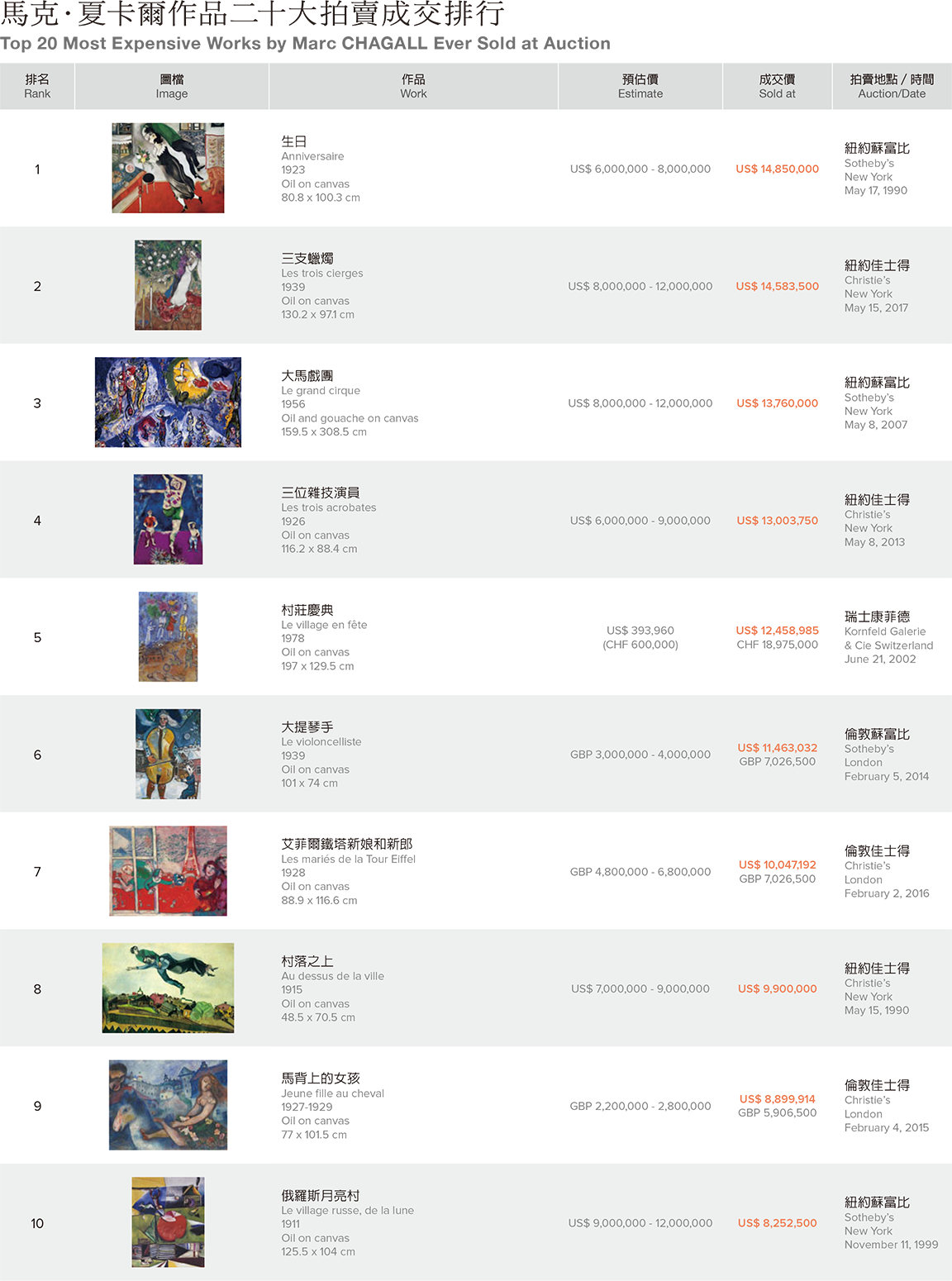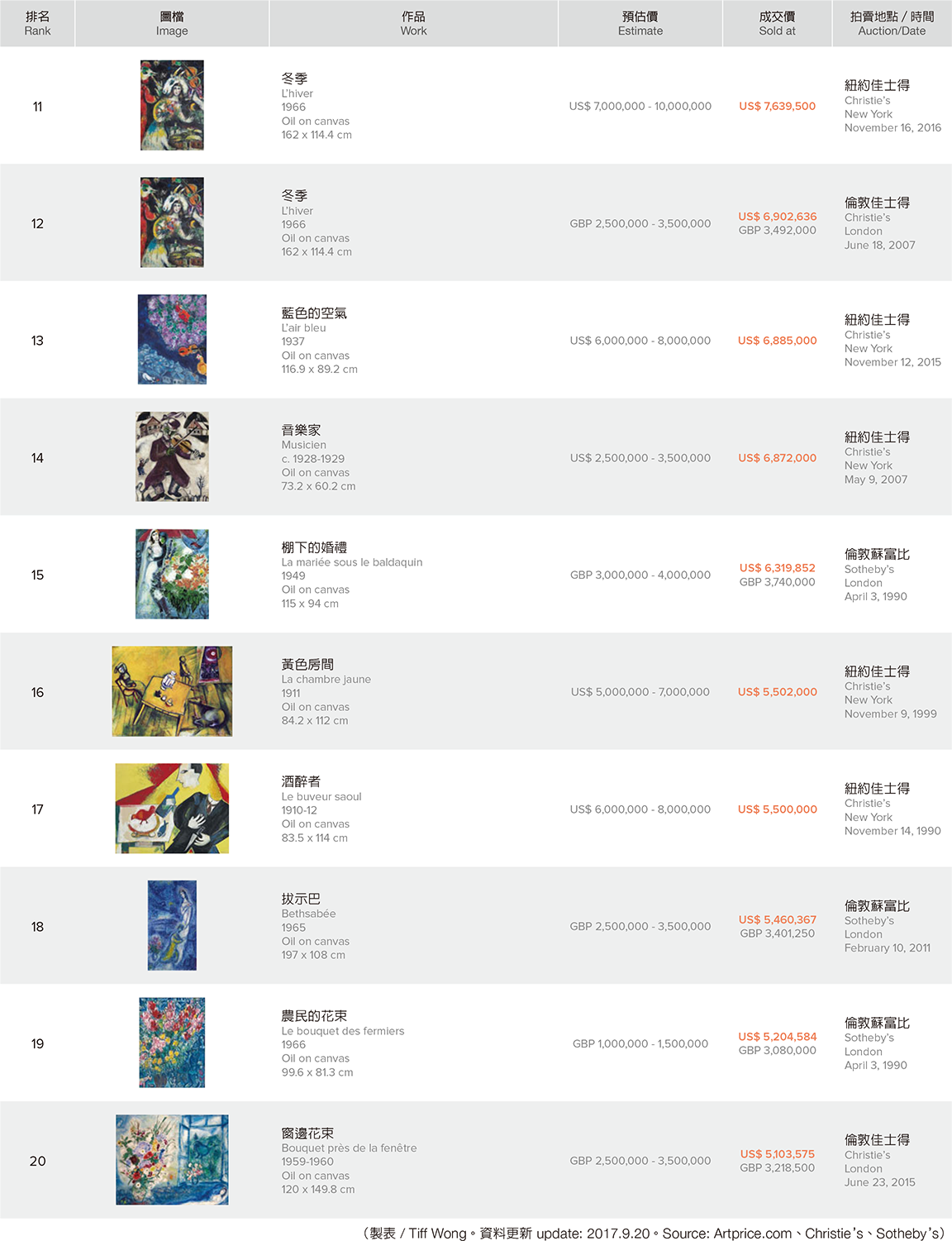“After Matisse, Chagall became the only person who really understands the color.” “Since Renoir, no one else has the same kind of sensitivity of the use of light like Chagall.” These compliments came from the words of the Master of art, Picasso. They have come to Paris in the early twentieth century to be a master of art, the two of them became the two best members of the Ecole de Paris. Artists who shared the same thoughts, common visions, together they have made their glorious time in the most brilliant history of Modern European art. Color magician Chagall, devoted a life time in painting to overcome nostalgia, and pass on love and his beliefs, his works are filled with warmth and soft feelings.
130th Birthday of Marc Chagall
2017 marks the 130th birthday of Marc Chagall. The Los Angeles County Museum of Fine Arts has been showing “Chagall: Fantasies for the Stage” since July, highlighting the stage costumes he designed for four ballets and operas from the 1940s to the 1970s. This is the period after Chagall came to live in the United States, escaping the war in Europe,expressing his cross-domain talent marked by bright colors, bold lines and unusual forms. Though art is the focus of the exhibition, the location of the museum stimulates the imagination, which, coupled with Chagall’s unbounded cross - d o m a i n c r e a t i v i t y, renders this exhibition at the Los Angeles County Museum of Fine Arts an unparalleled and unique scene.
The Kunstmuseum Basel opened the three-month special exhibition “Chagall: The Breakthrough Years, 1911-1919” on September 10, 2017, highlighting the early creations of the artist from a period of two contrasting stages of his life, his early period in Paris and his return to Russia. He combined inspiration from the nascent Paris avant-garde with elements of traditional Russian Jewish provincial life to draw out a distinctive creative flair. Most of the works in this collection come from the Kunstmuseum Basel and the Im Obersteg Foundation as well as other works on loan from international private collections.
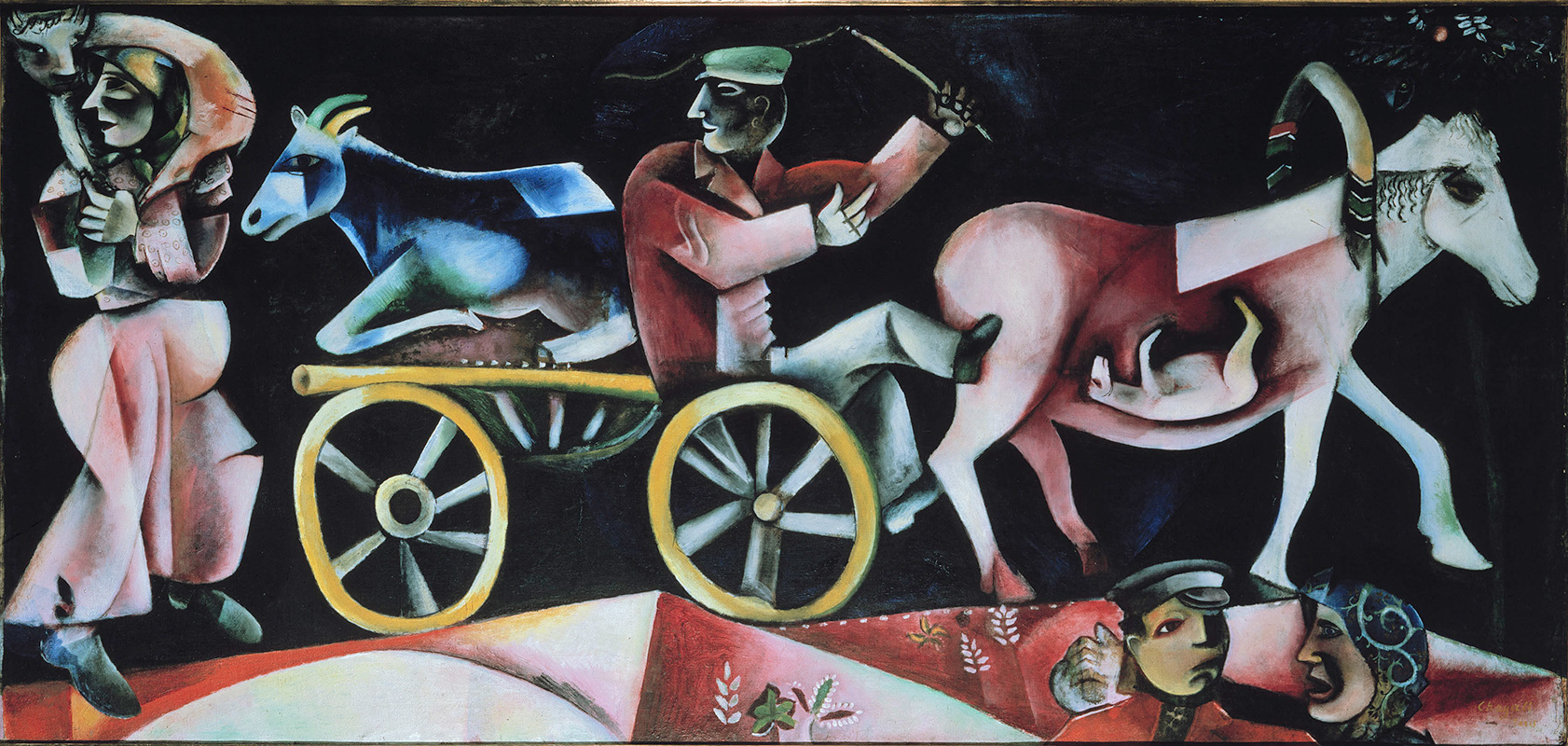
“Le marchand de bestiaux”, 1912 oil on canvas, 97x200.5 cm Collection of Kunstmuseum Basel
After returning to France from the United States, Chagall yearned for the Mediterranean lifestyle, so from the 1950s onward he settled in the south of France continuing to create poetic and imaginative paintings. The Musée Marc Chagall in Nice, planned in Chagall’s lifetime, is a national museum hosting the largest collection of Chagall’s works with over 400 oil paintings, gouaches, watercolors and drawings, including Chagall’s vibrant paintings inspired by vistas of the countryside of southern France. Because the museum also displays 17 paintings Chagall offered to the French government from his bible illustrations, the Museum is also known as Musée National Message Biblique Marc Chagall. In the summer of 2017, this museum also exhibited Chagall ’s sculptures, testimony to his diverse talent.
At Chagall’s birthplace of Vitebsk in Belorussia, the Marc Chagall Museum displays more than 300 of his paintings. The Museum of Modern Art in New York, the Tate Modern Art Museum in London, the Tel Aviv Museum of Art in Israel, the Albertina in Vienna all have impressive collections of Chagall’s work.
Surrealism Painter
While there is no doubt that Mark Chagall is an outstanding master of European modernism, he is also representative of the Surrealist School. After the First World War, surrealism burgeoned in Paris art circles. With origins in Dadaism, the philosophy is rooted in Freud’s psychoanalysis and Bergson’s intuitionism. It is said that the term “surrealism” was invented by the French poet Apollinaire to describe Chagall’s work. He described Chagall’s work as “supernatural,” reflecting surrealism’s original appellation of “supernaturalism”.
As if exploring the subconscious, pondering death, the past and the future, describing the contortions and contradictions of the world manifest, all of these are domains explored by the School of Surrealism, a school which created innumerable well-known works of art in the 20th century. This important period in painting is well represented by René Magritte, Joan Miró, Giorgio de Chirico, Paul Delvaux, Alberto Giacometti, Max Ernst, Salvador Dali and of course Marc Chagall – who together wrote an important chapter in the beautiful history of art.
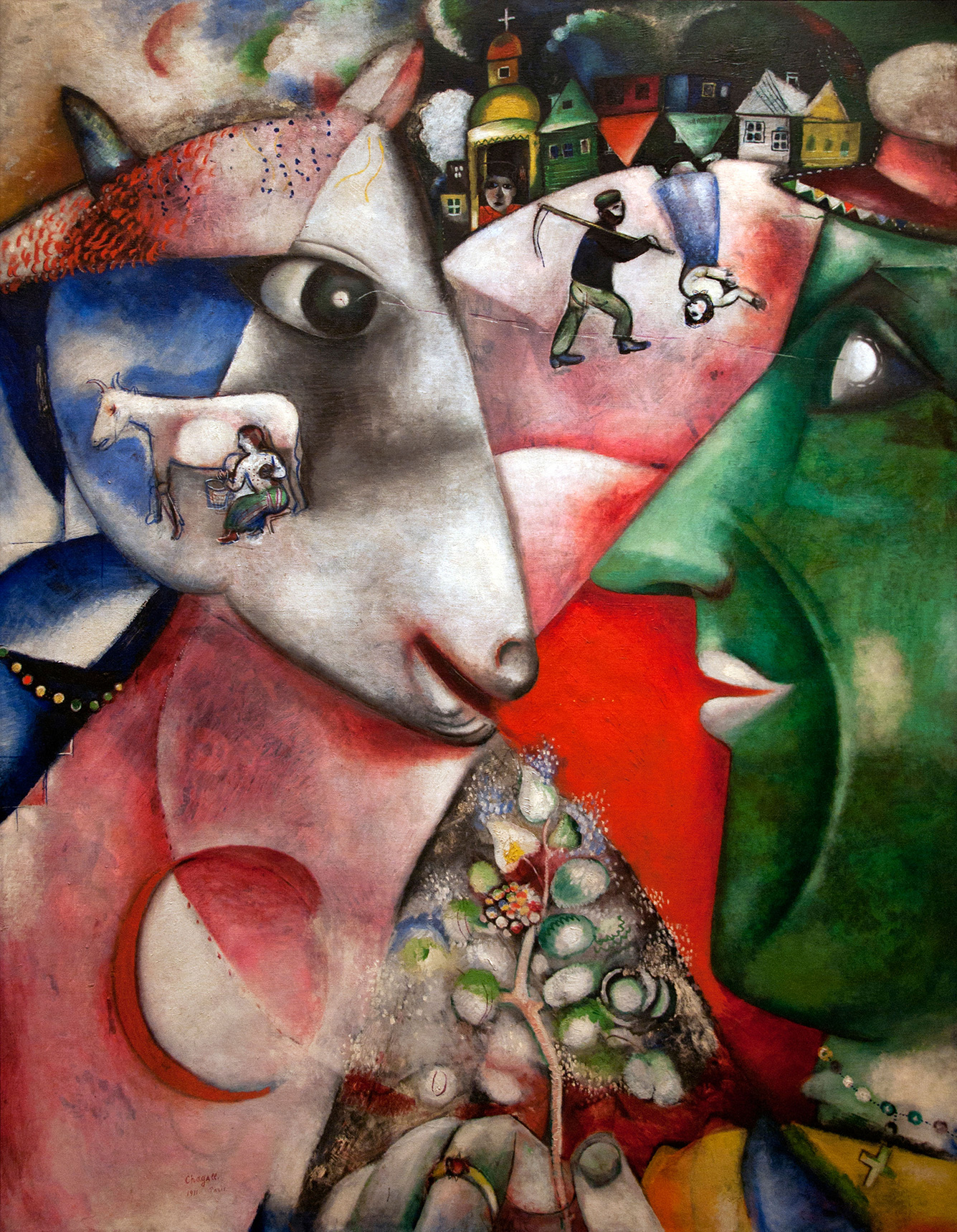
“I and the Village”, 1911 oil on canvas, 192.1 x 151.4 cm
Collection of Museum of Modern Art, New York.
This early work clearly shows both the Cubist and Fauvist influences at play in Chagall’s canvas.
© 2017 Artists Rights Society (ARS), New York / ADAGP, Paris
Chagall’s early work, progressively influenced by Fauvism, Cubism and Suprematism, gradually developed into the style of surrealism. During the same period many painters joined in the exploration of abstract painting. Chagall, however, deeply believed in the great power of figurative painting and narrative art, refusing the allure of abstract art throughout his lifetime, and deepening into the traditional figurative style with distinct coloring and modeling techniques to create a uniquely individual artistic language, and emerging as one of the most important painters of the 20th century.
On July 7th of 1887, Marc Chagall was born into a Jewish family in a Russian farming village. He was the eldest son of ten children in a poor family. His mother encouraged him along the path of art, sending him to St. Petersburg to study. In 1910 he traveled to Paris where he met Robert Delaunay, Fernand Léger and other avant-garde artists. After the close of the war in 1920 he returned to Paris to become a surrealist painter. Chagall lived a long life, passing away in 1985 in SaintPaul-de-Vence in southern France at the age of 98, having painted continuously to the last days of his life. Throughout his lifetime he used painting to confirm his faith in love, having once said, “Only love interests me, and I am only in contact with things that revolve around love.”
Though Chagall’s paintings conveyed love and good fortune, his life story is one of poverty, war, Jewish persecution and the death of loved ones. He transformed his pain into love and dreams. In 1914, as Europe was on the brink of the First World War, he left Paris to return to Russia, only to go back to Paris eight years later. In his hometown during the war, he meets and marries the daughter of a wealthy family, Bella Rosenfield. He falls in love with the elegant and cultured Bella at first sight. Bella’s love became an important source of creativity for Chagall and her beauty his inspiring muse throughout his life. His wife’s passing at the age of 58 in 1944 hit him hard. In 1952, at the age of 65, Chagall marries again to a Russian woman, Valentina Brodsky, nicknamed Vava, who accompanies him to the end of his life.
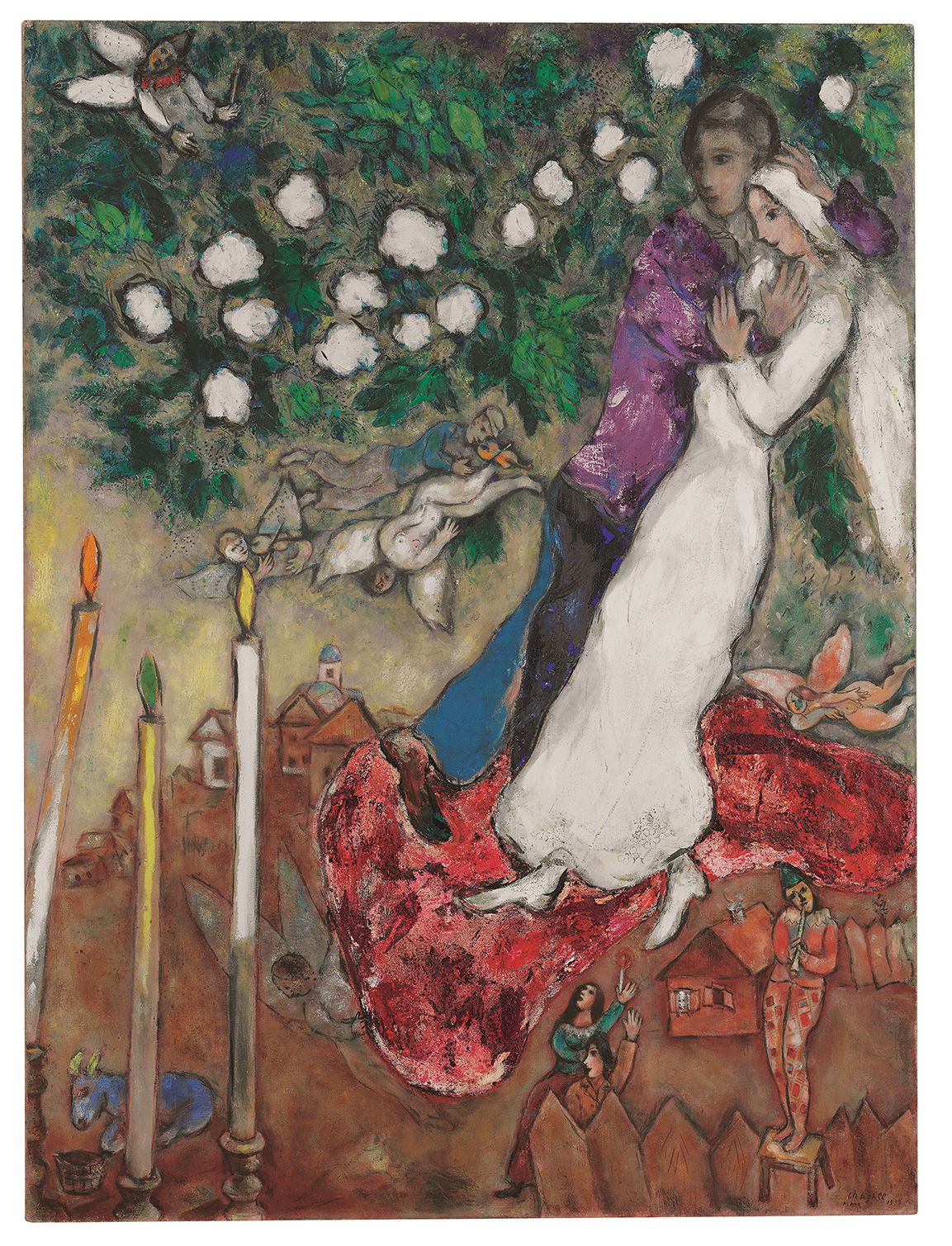
“Les trios cierges”, 1939 oil on canvas, 130.2x97.1 cm
Sold for US$14,583,500 Christie’s New York Spring 2017
Chagall’s work is figurative with poetic imagination. His art is resplendent with love and memories of his country home. Sometimes he creates a religious story to convey the sense of a story or fable. His art emanates from his hometown in Russia, stretching to the whole of Europe, and even to the United States and Asia. Chagall’s artwork makes the world a better place and his paintings are prized by art collectors around the world. Having traveled to many places throughout his life, his personal image and his art perfectly capture the essence of a visitor from afar.
Picasso and Chagall both traveled overseas to study art and were fast companions. They were also representative of the early School of Paris artists. Picasso once said: “When Matisse dies, Chagall will be the only painter left who understands what color really is. I’m not crazy about his roosters and asses and flying violinists, and all the folklore, but his canvases are really painted, not just thrown together. Some of the last things he’s done in Vence convince me that there’s never been anybody since Renoir who has the feeling for light that Chagall has.” This quote reveals the depth of their friendship. After Marc Chagall became well known, his work was received by galleries, museums and collectors, including work on paper, prints, stage design and costumes in addition to his oil paintings. But he also loved public art, such as stained glass, hoping that the public might have the opportunity to appreciate his work. Some of his later well-known works include stained glass windows for the synagogue of Hebrew University’s Hadassah Medical Center in Jerusalem (1961), the dome ceiling of the Paris opera (1964) and murals for the New York Metropolitan Opera. In March of 1985 he passed away in Saint-Paul-de-Vence in southern France, having enjoyed a rich life of 98 years. The arc of his life drew a beautiful canvas, depicting numerous innocent loves and dreams, his work conveying the warmest and softest love of the human heart.
The Market for Chagall’s Art
According to statistics on Artprice.com, in recent years, the sale of Chagall’s work in global auctions have been in the top 30, reaching a ranking of 6th in 2005-2006. In 2016, his work was ranked 16th globally, with annual trading volume of 79 million USD (approximately 2.4 billion TWD). Chagall’s work is often found in auctions around the world, where oil paintings, brocades, pastels and prints are abundant and circulation is high. The failure of two of Chagall’s paintings to sell at Christie’s Shanghai in September, is not an indicator of poor market demand for Chagall’s work, but rather an indication that the Shanghai market remains focused on Chinese art and has not yet realized the high valuations of Western art.

“Anniversaire”, 1915 oil on cardboard, 80.6x99.7 cm Collection of MoMA, New York
On May 15 , 2017 at New York Christie’s, the number 60 oil painting “Les trois cierges” sold for 14.583,500 US dollars (nearly 440 million Taiwan dollars), setting the record for the second highest auction for a Chagall, ranking second among auction records for Chagalls’ works, having not reached the highest level of 14.85 million US dollars paid at auction for number 40, “Anniversaire” on May 17, 1990 at Sotheby’s in New York. Chagall, a globally renowned artist who has transcended national boundaries, has not yet surpassed the sales records of the Chinese painter Zao Wou Ki, whose oil painting “29.09.64” achieved a selling price of 197.1 million USD in May of 2017. Statistics at Artprice.com show that in 2016 Zao Wou Ki’s global auction ranking rose to 14, with total sales for the year of about 81.2 million US dollars (about 2.44 billion Taiwan dollars). Actually, the trading levels of these two artists are comparable. Chagall’s works are plentiful and ample space remains for him in the marketplace. Though his pastels and prints have seen high values, sets of print books have surpassed the one million 1 USD level in the market.
Chagall’s “Femme Bleue, Âne Rouge” Fall Auction Focus
In 1969, construction began on the Musée Marc Chagall in Nice. His expectations were high at the time and his artistic accomplishment outstanding, having also caught the attention and high praise of the French government. That year he painted “Femme Bleue, Âne Rouge” true to his previous convention, animals are red, the face is green and the woman’s body is blue against a background of rural farmland. In the foreground a woman appears to fly with an animal as if in a dream, colorfully festive and joyful. Chagall likes flying in his paintings, as it brings a sense of stability in the absence of gravity. A fantastic imagination of the self is a signature expression of surrealist painters. Animals in the paintings of Chagall tend to have gigantic proportions within the frame. The arresting arrangement coupled with exaggerated colors bring out the importance of animals in his paintings. This also reflects the hardship of the artist’s Jewish upbringing as man’s existence depends on the sacrifice of animals. When Chagall fixed his gaze on the animal in the painting, as he has done in painting the donkey red, it is a projection of his inner sentiment. You can also see in the looking back of the donkey a kind of reflection, as the donkey fixes a wide eye on the painter.
Critics feel that the charm of Chagall’s painting surpasses the limitations of human inspiration. The floating, flying and jumping in his painting symbolize escape from the constraints of reality. He brings powerful poetic reserves to the canvas and his subjects are resplendent in the bold vitality of life, as if the images in the painting are dreaming, expressing human longing for joy and happiness. Whether the unrealistic blue-haired woman or red donkey, they are mysterious visual traps deliberately set by the artist. When we focus on the screen, spiritual analysis, acceptance and adjustment enables the viewer to also experience the scene in the painting, experience the passion and imagination created by the artist, like the beauty of reading poetry. This is why countless viewers have been drawn to and fascinated by Chagall’s paintings, reveling amongst them.
